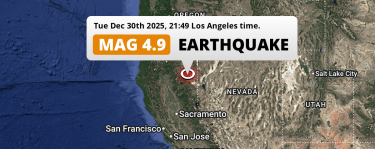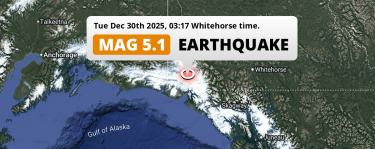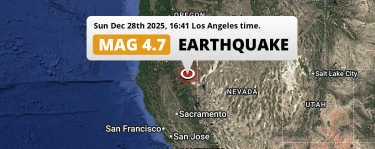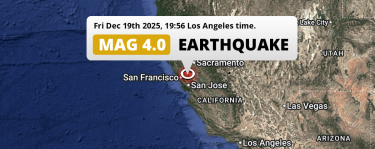 Read this article
Read this article
Latest earthquakes near The United States today
Complete overview of the latest earthquakes near the country The United States, updated every minute. Did you feel an earthquake today in The United States? If an earthquake is happening right now near The United States (also known as U.S.A.), it will show up within minutes.
Recent The United States Earthquake News
These are the latest articles published related to earthquakes occurring near The United States. Check our Earthquake News section for a complete overview of articles written on earthquakes near The United States and elsewhere.
The United States Earthquake Statistics
Average
A total of 1751 earthquakes with a magnitude of four or above have struck within 186 mi (300 km) of The United States in the past 10 years. This comes down to a yearly average of 175 earthquakes per year, or 14 per month. On average an earthquake will hit near The United States roughly every 2 days.
A relatively large number of earthquakes occurred near The United States in 2018. A total of 245 earthquakes (mag 4+) were detected within 186 mi of The United States that year. The strongest had a 7.1 magnitude.

Magnitude Distribution
The table below visualizes the distribution of all earthquakes that occurred within 300km of The United States in the past 10 years. No earthquakes with a magnitude of 8 or above have occurred near The United States during this time. Usually, higher magnitudes are less common than lower magnitudes. Small earthquakes with a magnitude below 4 on the Richter scale have been omitted from this overview.
| Magnitude | Earthquakes | Percentage |
|---|---|---|
| Mag. 4 | 1546 | 88.29% |
| Mag. 5 | 187 | 10.68% |
| Mag. 6 | 14 | 0.8% |
| Mag. 7 | 4 | 0.23% |
| Mag. 8 | 0 | 0.0% |
| Mag. 9 | 0 | 0.0% |
| Mag. 10 | 0 | 0.0% |
Strongest earthquakes near The United States
The strongest recent earthquake of the past 10 years near The United States occurred on Jul 5, 2019 20:19 local time (America/Los_Angeles timezone). It had a magnitude of 7.1 and struck 124 miles (200 km) north-northeast of Los Angeles, at a depth of 5 mi . Discover more strong earthquakes near The United States in the list below.
A longer time ago, a MAG-9.2 earthquake struck on Mar 27, 1964 17:36, 88 miles (142 km) north-northeast of Anchorage. It is the strongest earthquake near The United States in the past 126 years (Our data goes back to January 1st, 1900).
In the table below you will find the strongest earthquakes that occurred near The United States in the past 10 years. You can use the tabs to find the heaviest historic earthquakes since the year 1900 or within a specific year or distance from The United States.
Earthquakes by region of The United States
Click the links below for earthquake reports for regions in The United States.
- Alabama
- Alaska
- Arizona
- Arkansas
- California
- Colorado
- Connecticut
- Delaware
- Florida
- Georgia
- Hawaii
- Idaho
- Illinois
- Indiana
- Iowa
- Kansas
- Kentucky
- Louisiana
- Maine
- Maryland
- Massachusetts
- Michigan
- Minnesota
- Mississippi
- Missouri
- Montana
- Nebraska
- Nevada
- New Hampshire
- New Jersey
- New Mexico
- New York
- North Carolina
- North Dakota
- Ohio
- Oklahoma
- Oregon
- Pennsylvania
- Rhode Island
- South Carolina
- South Dakota
- Tennessee
- Texas
- Utah
- Vermont
- Virginia
- Washington
- Washington, D.C.
- West Virginia
- Wisconsin
- Wyoming
Frequently Asked Questions
These questions are commonly asked in relation to earthquakes occurring near The United States.
When was the last earthquake in The United States?
A 2.8 magnitude earthquake hit near The United States on the night of January 20, 2026 at 00:56 local time (America/Anchorage). The center of this earthquake was located 88km north-northeast of Anchorage at a depth of 0km under land. Check the list on our website for any earthquakes occurring near The United States in the past hours.
What was the strongest earthquake near The United States?
A 9.2 magnitude earthquake hit near The United States on the afternoon of March 27, 1964 at 17:36 local time (America/Anchorage). The center of this earthquake was located 142km east-southeast of Anchorage at a depth of 25km under land. This is the strongest earthquake that occurred near The United States since the year 1900.
How often do earthquakes occur near The United States?
In the past 10 years, 1751 earthquakes with a magnitude of four or higher occurred within a 300 kilometer range from The United States. This averages to 175 earthquakes yearly, or one earthquake every 2 days.





 Jan 19, 2026 05:56PM
On Monday Afternoon a Shallow M4.9 Earthquake struck near Indio in The United States.
Jan 19, 2026 05:56PM
On Monday Afternoon a Shallow M4.9 Earthquake struck near Indio in The United States.
 Jan 13, 2026 01:10PM
On Tuesday Afternoon a Shallow M4.4 Earthquake struck near Ukiah in The United States.
Jan 13, 2026 01:10PM
On Tuesday Afternoon a Shallow M4.4 Earthquake struck near Ukiah in The United States.
 Dec 30, 2025 09:49PM
Shallow M4.9 Earthquake hit near Susanville in The United States on Tuesday Evening.
Dec 30, 2025 09:49PM
Shallow M4.9 Earthquake hit near Susanville in The United States on Tuesday Evening.
 Dec 30, 2025 01:17AM
Shallow M5.1 FORESHOCK struck on Tuesday Night 251km from Whitehorse in Canada.
Dec 30, 2025 01:17AM
Shallow M5.1 FORESHOCK struck on Tuesday Night 251km from Whitehorse in Canada.
 Dec 28, 2025 04:41PM
Shallow M4.7 Earthquake struck on Sunday Afternoon near Susanville in The United States.
Dec 28, 2025 04:41PM
Shallow M4.7 Earthquake struck on Sunday Afternoon near Susanville in The United States.
 Dec 19, 2025 07:56PM
On Friday Evening a Shallow M4.0 Earthquake struck near San Ramon in The United States.
Dec 19, 2025 07:56PM
On Friday Evening a Shallow M4.0 Earthquake struck near San Ramon in The United States.
